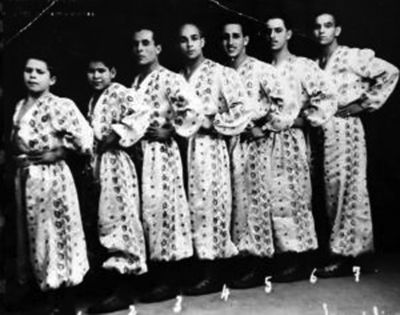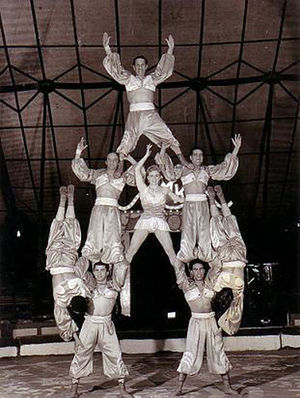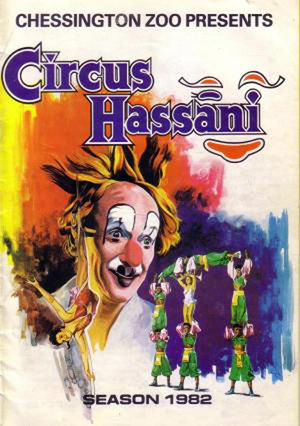Ali Hassani
From Circopedia
Acrobat, Circus Owner
By Dominique Jando and Donald Stacey
For some thirty years, Ali Hassani (1927-2010) ran the world's most famous troupe of Moroccan tumblers—and one of the best indeed in the entertainment business—before becoming a circus owner and producer in his adopted England. Yet, this highly respected artist and impresario came to the circus quite by accident, and in very unusual circumstances.
Ali Houssain And The Moroccan Tumblers
Ali Hassani was born Ali Houssain in a village on the outskirts of Marrakech, in Morocco, on March 7, 1927. Morocco has an age-long tradition of itinerant troupes of acrobats specializing in tumbling and building human pyramids, which for centuries have traveled from market places to village squares. They have been part of the circus practically since its inception, and can still be seen today in the ring, performing their traditional acrobatic skills in a style of presentation that has remained by and large unchanged.Ali belonged to a poor family of thirteen children, and he and his siblings were often left to their own devices to scrap some food or make a few dirhams in the streets of Marrakech. One day, as he was watching a group of tumblers on Djama Al Ifna, a square in Marrakech, Ali, who was seven at the time, was abducted by the acrobats, who saw him as an ideal "top mounterIn an acrobatic or balancing act, the performer who holds the top position (on a human column, for instance)."—the light acrobat who stood at the top of their human pyramids.
It must be stressed, though, that Ali was not an unwilling participant; according to his daughter Zayna, "He used to run and watch as a child and the tumblers said 'do you want to do this?' and he was quite cheeky apparently and said 'yes' and they actually took him away with them." Nonetheless, his life changed forever, and he was never to see his parents or siblings again, in spite of his attempts at tracking them years later when he returned to Morocco.
The tumbling troupe, with young Ali in tow, found engagements in neighboring Spain, where they remained through the Spanish Civil War (1936-1939) and WWII, since Spain was neutral in the conflict. As an apprentice to the troupe, Ali was not paid: he was just given food and shelter, and the bare necessities of life. Yet, he enjoyed his new life and over the years, he became an excellent tumbler, eventually moving from a light top-mounter to a sturdy bottom man as he grew up.
The Hassani Troupe
The troupe continued to work in Europe, before securing an engagement at Billy Smart’s Circus in Great Britain in 1950. There, Ali's life would take another turn. While performing with the Billy Smart show (where contracts were often renewed from year to year), he met Tamara Polakovs. Tamara was the daughter of the legendary Coco (Nicholai Polakovs, 1900-1974), who had long been associated with the Bertram Mills Circus and had become its iconic clownGeneric term for all clowns and augustes. '''Specific:''' In Europe, the elegant, whiteface character who plays the role of the straight man to the Auguste in a clown team..
In 1951 Tamara and her brothers Sascha and Michael had left Mills, where the shadow of their father no doubt loomed a little too large, to join the Billy Smart show. They performed an act that combined slapstick clowning with acrobatics and trampoline. Tamara fell for Hassani, who had become by then a powerful athlete capable of supporting seven or more fellow acrobats on his shoulders and around his body—a feat that was known in the early days of the circus as Les Colonnes d’Hercule ("Hercules’s Columns").Thus Ali, a Muslim, and Tamara, a Jew, got married (in the circus world, such details are of no importance: all belong to the same nation, or culture, the Circus), and the couple left Billy Smart and went their own way. They formed a new Moroccan tumbling act, the Hassani Troupe—in which Tamara and, in time, their three daughters, Zayna, Susi and Mina, took part. Their act was spectacular and highly skilled, enhanced by colorful costumes created under Tamara's supervision, and it soon was much in demand in circuses all over Europe.
Over the years they appeared in such venues as the Great Yarmouth Hippodrome the Belle Vue International Circus in Manchester, Blackpool’s Tower Circus, Glasgow’s Kelvin Hall Circus, the London Palladium, and the Royal Albert Hall in Great Britain. On the continent, they were featured at Switzerland’s Circus Knie; Cirque Amar and Cirque Bouglione in France; Paris’s Cirque d’Hiver; and Circus Krone, Circus Barnum and Circus Willy Hagenbeck in Germany—among others.
They also appeared on television, notably on The Paul Daniels Magic Show, and in Christmas pantomimes—an important British institution—and they performed for Princess Grace at Monaco's Bal de la Rose. In the mid-1970s, they crossed the Atlantic and went on to perform in the United States, at the Stardust Hotel & Casino in Las Vegas, and later with Ringling Bros. and Barnum & Bailey's Greatest Show on Earth.
A large part of the troupe's success in the entertainment business was due to Hassani's professionalism. For circus producers, Ali’s word was regarded as his bond; his troupe always showed up in time, with one more performer than required in case of injury. He carefully selected the various Moroccan acrobats who composed the troupe—sometimes returning to Marrakech to find them. His act was technically strong, energetic, and vastly entertaining. From talent to costumes, nothing was left to chance.
In 1981 the Hassani troupe was contracted to perform on the inaugural Canadian tour of the newly created (and very-short-lived) Circus Tivoli, the brainchild of J. Sergei Sawchyn, a former General Manager of the Royal Winnipeg Ballet. The entire venture (which was very costly since all the equipment was brand new) was ill prepared and the production was in trouble from the start. Ali Hassani was drafted in as an assistant ringmaster(American, English) The name given today to the old position of Equestrian Director, and by extension, to the presenter of the show. to lend some of his experience to the proceedings, but that was not enough to save the enterprise, which collapsed soon after the beginning of the season.
On one occasion during a performance at Circus Tivoli, a brown bear escaped from the ring and seemed set to attack a small boy seating in the front row. Hassani and his hugely powerful star bottom-man, Tahar Douis (who would become later a circus star in his own right), jumped to the rescue; witnesses described them as looking like nightclub bouncers ejecting an unruly client—frogmarching the misbehaving creature to the wings in unruffled fashion…
From Circus Hassani To Tamara Coco’s Circus
By then Ali and Tamara had already invested all their savings in their own circus, Circus Hassani, which they launched in 1979 and was Britain's first circus without animals. Unfortunately, as much as animal-rights activists praised it, it was a flop with the public. Luckily, in 1982, Circus Hassani found a permanent home at the Chessington Zoo (today Chessington World of Adventures Resort), southwest of London, where it succeeded the old Gilberts Circus and continued to present all-human circus shows.That same year, the Hassani Troupe were cast in John Glen’s James Bond film, Octopussy (released in1983), which marked the beginning of a friendship between Ali and Tamara and Barbara Broccoli, the daughter of the film’s producer, Albert R. Broccoli. In 1983, Hassani’s circus was renamed Tamara Coco’s Circus. Ali and Tamara also opened a second unit, called International Circus Hassani, at the Alton Towers Theme Park in Staffordshire.
The circus at the Chessington Zoo lasted until 1997, but it suffered a setback in 1987 when the uninsured Big Top was destroyed by a extraordinarily violent storm, quite unusual in England. This didn’t discourage Ali, who quickly rebuilt his circus at his own expense. Tamara Hassani died a year later in November 1988. Despite the loss of his wife and partner, Hassani continued to work as a circus impresario, and to impart his enormous expertise on the art of tumbling to young acrobats. In time, the Chessington Zoo took care of the production of the shows, although Hassani continued to provide equipment and technical support.
Soon after Tamara’s passing, Ali met a young Moroccan girl, Souad, who was visiting her sister in Chessington. He married her in 1991, and she gave him a son, Yasim. Seen by his colleagues, friends and employees as a true gentleman, Ali Hassani was a very generous man; he gave money to charitable organizations in Marrakech and elsewhere, and for many years after his retirement, Ali and Souad fostered young children in their home at West Ewell, in the borough of Epsom, Surrey. Ali Hassani died at home on January 16, 2010, at age eighty-three.
His funeral, three days later, was attended by many circus artists and directors, including former acrobats of the Hassani Troupe who came from all over Europe; several of them carried the coffin of their beloved “Boss” to his last resting place at Surbiton Cemetery, at Kingston upon Thames, after a service at Kingston Mosque. One of them remembered, "He didn’t mess around. He went through every detail—the way you stand, the way you tumble. He gave you courage as well. You were scared to do something wrong."
See Also
- Video: The Hassani Troupe, Moroccan tumblers, in Live From The Hippodrome (1966)









